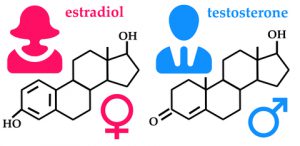
Moving Forward from the Chit-Chat on Lavender Oil, Tea Tree Oil, and Man Boobs
Last week, I focused on debunking the latest, among many, misleading media-hypes about essential oils. The most current claimed that a study “proved” that lavender and tea tree oil were “endocrine disruptors.” This “evidence” was a repeat of a bad-tasting regurgitation of an earlier study which was an inconclusive extrapolation that lavender and tea tree essential oils could cause boys to develop breasts, gynecomastia. Both of these “scientific reports” left a very bad taste in my mouth.
This propelled me to review this claim in more detail in my two-part series. In it, I provided several reasons why the conclusion was not accurate. Still a bit disturbed, I realized I wanted to reach more practitioners who may be frightened away from using these essential oils in their young population. For this reason, you may see a published article in a physician’s journal on the very same topic. I’ll keep you posted. 😉
In this next series of articles, I’m going to focus on specific essential oils that may have gotten similar bad press and blamed for causing hormonal disruption. Specifically, I want to review a few oils that are believed to be “estrogenic,” having an action or effect similar to estrogen. (source)
First, I will review all of the factors I brought up with the latest headlines. This is because they are applicable and imperative to understand as we move forward with the hormonal impact of specific essential oils.

Summary of the Aspects to Consider When Evaluating the Action of Essential Oils from a Study
In part one of my review of the hormonal effects of lavender and tea tree oil, I explained the following points to keep in mind:
- Essential oils have diverse effects based on their environment. They have been found to exhibit different properties in petri dishes, rodents, and in human beings.
- Petri dish studies can easily be made invalid due to several methodological flaws and cannot be deemed as fact based on one study.
- Previous scares were based on cases that contained tea tree and lavender oil in consumer products. They were not related to the therapeutic, grade essential oils themselves. Rather, these essential oils were found within items with known endocrine disruption, biasing the results.
In part two, I discussed the experimental methods used in the study and the flaws in more detail. Methods are important to understand and review to determine if the results are generalizable to humans. In the current experiment, the researchers’ report of endocrine disruption of tea tree and lavender essential oils was based on isolating only eight constituents deemed important. These compounds were concentrated and placed into a dish with human cancer cells. Their effect on estrogen and androgen receptors and genetic transcription was assessed. This comparison of isolates is not equivocal to actually testing an essential oil with all of its hundreds of compounds present synergistically.
Below is a continuation of the reasons why isolating constituents from the whole substance and inferring their outcomes for any essential oil is a mistake.
- Similar to the statement above about essential oils, studies have found that isolated constituents also have differing effects in petri dishes, cell cultures, and living creatures.
- Synergistic, therapeutic essential oil have not been found to behave the same way in the male body as in cell cultures.
- There is a difference in actions and absorption of synthetic compounds versus natural compounds. They will also vary in how they will be processed and eliminated in the body.
- Plant estrogens act selectively and are based on the “estrogenic environment.” They can bring balance to hormones based on multiple actions of their various constituents and the different biochemical, physiological, and psychological pathways they effect.
- The action of essential oils have individualistic effects which are based on ones’ genetic variances, microbiota diversity, and “internal environment.” This makes petri dish studies even more irrelevant with essential oils (Read more about that here.)
- Essential oils have been reported to have an “innate” healing ability.
- The safety of essential oils and hormonal modulation properties from previous research was not reviewed or considered.
With the above information in your brain, I’m hoping you can move forward with these series of blogs as a guide for you in two vital ways:
1. To help you decipher in the future if the media’s “scientific conclusions” are correctly extrapolated to humans, or at least to question them and seek more resources from the direct source or unbiased experts.
Previously, I discussed specific biases and issues to be aware of when reading about research on natural products, supplements, and vitamins which can also be used with essential oils. These be found at the following links: article 1, article 2, article 3.
2. By highlighting what the science reports, experts’ opinions, and my own opinions, you will be able to make an informed decision and check in with your own unique needs and body’s responses.
In my homepage blog, I begin with reviewing the “estrogenic” properties of clary sage essential oil.
Wait!
Before you go there, there’s one more thing to review to make sure essential oils create the desired response you expect…
 Essential Oils Safety First: Resources and Starting Points
Essential Oils Safety First: Resources and Starting Points
The fact is that the use of essential oils which considers correct dosage, application, and quality is exceedingly safe; however they must be used as directed and responsibly. If you are new to essential oils, or are unsure of their proper use and precautions for obtaining desired effects, please review the following safety information:
- Articles in my database under “Essential Oils for Health Topics”: “Children and Safety” (after the listing of single oils)
- Essential Oils and Medications– considerations and potential interactions
- These general guidelines
- Carrier oils– all those new to essential oils, I strongly recommend even more dilution than suggested on the bottles to start
- The 2015 Annual Report of the American Association of Poison Control Centers’ National Poison Data System (NPDS): 33rd Annual Report, essential oils summary page 140. You will be able to see first hand the toxicity is unalarming.
Now, you can click here for “A Review of the “Estrogenic” Essential Oils: Clary Sage Oil Part I.”
Many blessings from my heart to yours!
This material is for information purposes only and is not intended to diagnose, treat, or prescribe for any illness. You should check with your doctor regarding implementing any new strategies into your wellness regime. These statements have not been evaluated by the FDA. (Affiliation link.)
Disclaimer: This information is applicable ONLY for therapeutic quality essential oils. This information DOES NOT apply to essential oils that have not been tested for purity and standardized constituents. There is no quality control in the United States, and oils labeled as “100% pure” need only to contain 5% of the actual oil. The rest of the bottle can be filled with fillers and sometimes toxic ingredients that can irritate the skin. The studies are not based solely on a specific brand of an essential oil, unless stated. Please read the full study for more information.
Thanks Pixabay and iStock purchases.



